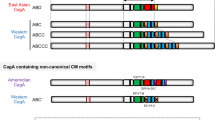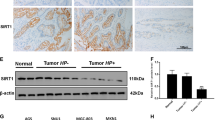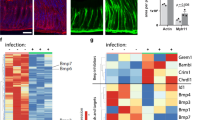Abstract
Helicobacter pylori infection is the major risk factor for gastric adenocarcinoma. The link with gastric adenocarcinoma is partly due to the H. pylori CagA oncoprotein. CagA is responsible for a particular cell phenotype in vitro, the ‘hummingbird’ phenotype, that corresponds to an elongation of the cells, mimicking an epithelial–mesenchymal transition (EMT). EMT participates in the carcinogenesis process, and is involved in the generation of cancer stem cells (CSCs). However, its involvement in gastric carcinogenesis has yet not been studied. Therefore, the aim of this study was to determine the role of H. pylori in EMT and in the emergence of gastric CSCs. For this purpose, gastric epithelial cells were cocultured with a cagA-positive H. pylori strain or its isogenic-deleted mutants or were transfected with CagA expression vectors. Study of the expression of epithelial and mesenchymal markers showed that H. pylori, via CagA, is responsible for an EMT phenotype associated with an increase in mesenchymal markers as well as CD44 expression, a known gastric CSC marker. Moreover, infection led to an increased ability to migrate, to invade and to form tumorspheres. Cell sorting experiments showed that only the CD44high cells induced by H. pylori infection displayed the mesenchymal phenotype and CSC properties in vitro, and had higher tumorigenic properties than CD44low cells in xenografted mice. Immunohistochemistry analyses on human and mouse gastric mucosa tissue samples confirmed a high expression of CD44 and mesenchymal markers in H. pylori-infected cases, and in gastric dysplasia and carcinoma. All of these data suggest that H. pylori, via CagA, unveils CSC-like properties by induction of EMT-like changes in gastric epithelial cells.
This is a preview of subscription content, access via your institution
Access options
Subscribe to this journal
Receive 50 print issues and online access
$259.00 per year
only $5.18 per issue
Buy this article
- Purchase on Springer Link
- Instant access to full article PDF
Prices may be subject to local taxes which are calculated during checkout






Similar content being viewed by others
References
IARC'Working'Group Schistosomes, liver flukes and Helicobacter pylori:Views and expert opinion of IARC Working Group on the evaluation of carcinogenic risks to humans. IARC Monographs (International Agency for Research on Cancer), Lyon, France, 1994; 61: 177–240.
Blaser MJ, Perez-Perez GI, Kleanthous H, Cover TL, Peek RM, Chyou PH et al. Infection with Helicobacter pylori strains possessing CagA is associated with an increased risk of developing adenocarcinoma of the stomach. Cancer Res 1995; 55: 2111–2115.
Gwack J, Shin A, Kim CS, Ko KP, Kim Y, Jun JK et al. CagA-producing Helicobacter pylori and increased risk of gastric cancer: a nested case-control study in Korea. Br J Cancer 2006; 95: 639–641.
Murata-Kamiya N, Kurashima Y, Teishikata Y, Yamahashi Y, Saito Y, Higashi H et al. Helicobacter pylori CagA interacts with E-cadherin and deregulates the beta-catenin signal that promotes intestinal transdifferentiation in gastric epithelial cells. Oncogene 2007; 26: 4617–4626.
Amieva MR, Vogelmann R, Covacci A, Tompkins LS, Nelson WJ, Falkow S . Disruption of the epithelial apical-junctional complex by Helicobacter pylori CagA. Science 2003; 300: 1430–1434.
Backert S, Selbach M . Role of type IV secretion in Helicobacter pylori pathogenesis. Cell Microbiol 2008; 10: 1573–1581.
Guarino M, Rubino B, Ballabio G . The role of epithelial-mesenchymal transition in cancer pathology. Pathology 2007; 39: 305–318.
Mani SA, Guo W, Liao MJ, Eaton EN, Ayyanan A, Zhou AY et al. The epithelial-mesenchymal transition generates cells with properties of stem cells. Cell 2008; 133: 704–715.
Morel AP, Lievre M, Thomas C, Hinkal G, Ansieau S, Puisieux A . Generation of breast cancer stem cells through epithelial-mesenchymal transition. PloS One 2008; 3: e2888.
Al-Hajj M, Wicha MS, Benito-Hernandez A, Morrison SJ, Clarke MF . Prospective identification of tumorigenic breast cancer cells. Proc Natl Acad Sci USA 2003; 100: 3983–3988.
Bellizzi A, Sebastian S, Ceglia P, Centonze M, Divella R, Manzillo EF et al. Co-expression of CD133(+) /CD44(+) in human colon cancer and liver metastasis. J Cell Physiol 2012; 228: 408–15s.
Hao J, Madigan MC, Khatri A, Power CA, Hung TT, Beretov J et al. In vitro and in vivo prostate cancer metastasis and chemoresistance can be modulated by expression of either CD44 or CD147. PloS One 2012; 7: e40716.
Kure S, Matsuda Y, Hagio M, Ueda J, Naito Z, Ishiwata T . Expression of cancer stem cell markers in pancreatic intraepithelial neoplasias and pancreatic ductal adenocarcinomas. Int J Oncol 2012; 41: 1314–1324.
Meng E, Long B, Sullivan P, McClellan S, Finan MA, Reed E et al. CD44+/CD24- ovarian cancer cells demonstrate cancer stem cell properties and correlate to survival. Clin Exp Metastasis 2012; 29: 939–948.
O'Brien CA, Pollett A, Gallinger S, Dick JE . A human colon cancer cell capable of initiating tumour growth in immunodeficient mice. Nature 2007; 445: 106–110.
Ricci-Vitiani L, Lombardi DG, Pilozzi E, Biffoni M, Todaro M, Peschle C et al. Identification and expansion of human colon-cancer-initiating cells. Nature 2007; 445: 111–115.
Su YJ, Lai HM, Chang YW, Chen GY, Lee JL . Direct reprogramming of stem cell properties in colon cancer cells by CD44. EMBO J 2011; 30: 3186–3199.
Takaishi S, Okumura T, Tu S, Wang SS, Shibata W, Vigneshwaran R et al. Identification of gastric cancer stem cells using the cell surface marker CD44. Stem Cells 2009; 27: 1006–1020.
Klarmann GJ, Hurt EM, Mathews LA, Zhang X, Duhagon MA, Mistree T et al. Invasive prostate cancer cells are tumor initiating cells that have a stem cell-like genomic signature. Clin Exp Metastasis 2009; 26: 433–446.
Li C, Lee CJ, Simeone DM . Identification of human pancreatic cancer stem cells. Methods Mol Biol 2009; 568: 161–173.
Viala J, Chaput C, Boneca IG, Cardona A, Girardin SE, Moran AP et al. Nod1 responds to peptidoglycan delivered by the Helicobacter pylori cag pathogenicity island. Nat Immunol 2004; 5: 1166–1174.
Mitsuno Y, Yoshida H, Maeda S, Ogura K, Hirata Y, Kawabe T et al. Helicobacter pylori induced transactivation of SRE and AP-1 through the ERK signalling pathway in gastric cancer cells. Gut 2001; 49: 18–22.
Saito Y, Murata-Kamiya N, Hirayama T, Ohba Y, Hatakeyama M . Conversion of Helicobacter pylori CagA from senescence inducer to oncogenic driver through polarity-dependent regulation of p21. J Exp Med 2010; 207: 2157–2174.
Varon C, Dubus P, Mazurier F, Asencio C, Chambonnier L, Ferrand J et al. Helicobacter pylori infection recruits bone marrow-derived cells that participate in gastric preneoplasia in mice. Gastroenterology 2012; 142: 281–291.
Baud J, Varon C, Chabas S, Chambonnier L, Darfeuille F, Staedel C . Helicobacter pylori initiates a mesenchymal transition through ZEB1 in gastric epithelial cells. PloS One 2013; 8: e60315.
Yin Y, Grabowska AM, Clarke PA, Whelband E, Robinson K, Argent RH et al. Helicobacter pylori potentiates epithelial:mesenchymal transition in gastric cancer: links to soluble HB-EGF, gastrin and matrix metalloproteinase-7. Gut 2010; 59: 1037–1045.
Backert S, Moese S, Selbach M, Brinkmann V, Meyer TF . Phosphorylation of tyrosine 972 of the Helicobacter pylori CagA protein is essential for induction of a scattering phenotype in gastric epithelial cells. Mol Microbiol 2001; 42: 631–644.
Ohnishi N, Yuasa H, Tanaka S, Sawa H, Miura M, Matsui A et al. Transgenic expression of Helicobacter pylori CagA induces gastrointestinal and hematopoietic neoplasms in mouse. Proc Natl Acad Sci USA 2008; 105: 1003–1008.
Yang MH, Hsu DS, Wang HW, Wang HJ, Lan HY, Yang WH et al. Bmi1 is essential in Twist1-induced epithelial-mesenchymal transition. Nat Cell Biol 2010; 12: 982–992.
Varon C, Duriez A, Lehours P, Menard A, Laye S, Zerbib F et al. Study of Helicobacter pullorum proinflammatory properties on human epithelial cells in vitro. Gut 2009; 58: 629–635.
Franco AT, Johnston E, Krishna U, Yamaoka Y, Israel DA, Nagy TA et al. Regulation of gastric carcinogenesis by Helicobacter pylori virulence factors. Cancer Res 2008; 68: 379–387.
Ferrand J, Lehours P, Schmid-Alliana A, Mégraud F, Varon C . Helicobacter pylori infection of gastrointestinal epithelial cells in vitro induces mesenchymal stem cell migration through an NF-kappaB-dependent pathway. PloS One 2011; 6: e29007.
Higashi H, Tsutsumi R, Muto S, Sugiyama T, Azuma T, Asaka M et al. SHP-2 tyrosine phosphatase as an intracellular target of Helicobacter pylori CagA protein. Science 2002; 295: 683–686.
Acknowledgements
This project was supported by the French ‘Association pour la Recherche contre le Cancer’ (grant number 8412), ‘Institut du Cancer’ (grant number 07/3D1616/IABC-23-12/NC-NG), ‘Conseil Regional d’Aquitaine’ (grant number 20071301017 and 20081302203). We thank D Collet (Digestive Surgery of Hospital Haut-Lévèque, University Hospital Center of Bordeaux, France) and Professor JP Merlio (Tumor Bank of University Hospital Center of Bordeaux, France) for providing human gastric tissue samples from consenting patients. We thank A Giese (EA2406, Bordeaux, France), B Rousseau (level 2 animal facilities, Université de Bordeaux), V Pitard and S Gonzalez (cytometry platform, Université de Bordeaux), A Ménard, M Alibert, E Siffre and L Biguet for technical support.
Author information
Authors and Affiliations
Corresponding author
Ethics declarations
Competing interests
The authors declare no conflict of interest.
Additional information
Supplementary Information accompanies this paper on the Oncogene website
Rights and permissions
About this article
Cite this article
Bessède, E., Staedel, C., Acuña Amador, L. et al. Helicobacter pylori generates cells with cancer stem cell properties via epithelial–mesenchymal transition-like changes. Oncogene 33, 4123–4131 (2014). https://doi.org/10.1038/onc.2013.380
Received:
Revised:
Accepted:
Published:
Issue Date:
DOI: https://doi.org/10.1038/onc.2013.380
Keywords
This article is cited by
-
Targeting metastasis-initiating cancer stem cells in gastric cancer with leukaemia inhibitory factor
Cell Death Discovery (2024)
-
FTO-mediated m6A modification promotes malignant transformation of gastric mucosal epithelial cells in chronic Cag A+ Helicobacter pylori infection
Journal of Cancer Research and Clinical Oncology (2023)
-
CD44v3 is a marker of invasive cancer stem cells driving metastasis in gastric carcinoma
Gastric Cancer (2023)
-
Synergistic effects of Rapamycin and Fluorouracil to treat a gastric tumor in a PTEN conditional deletion mouse model
Gastric Cancer (2022)
-
Autophagy induced by Helicobacter pylori infection is necessary for gastric cancer stem cell emergence
Gastric Cancer (2021)



